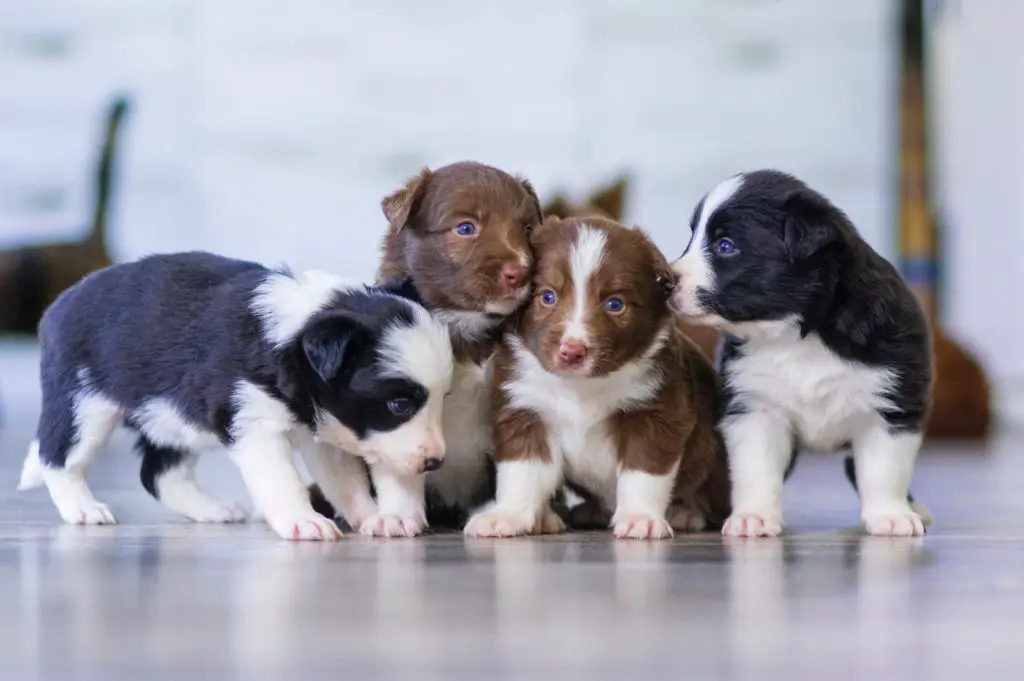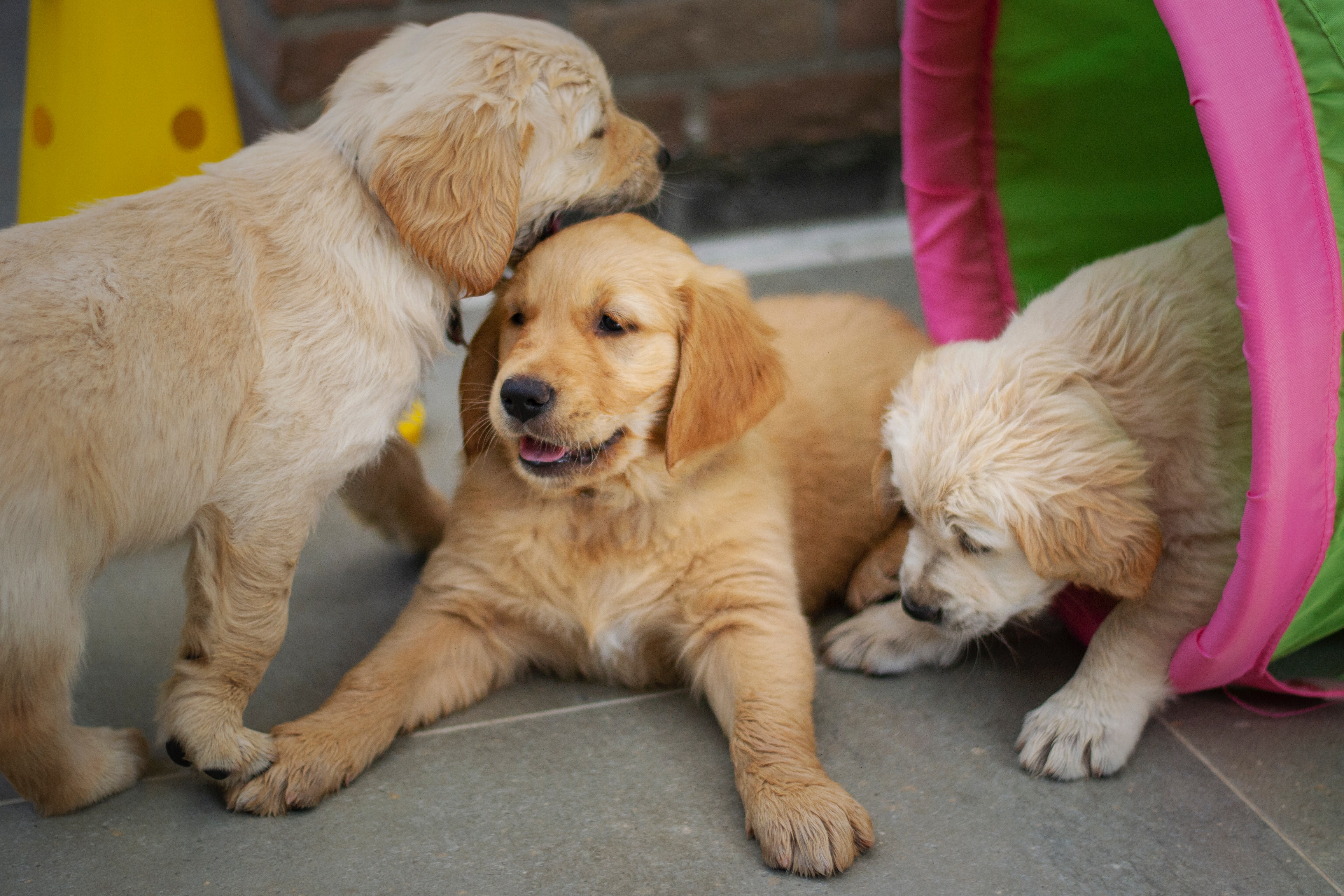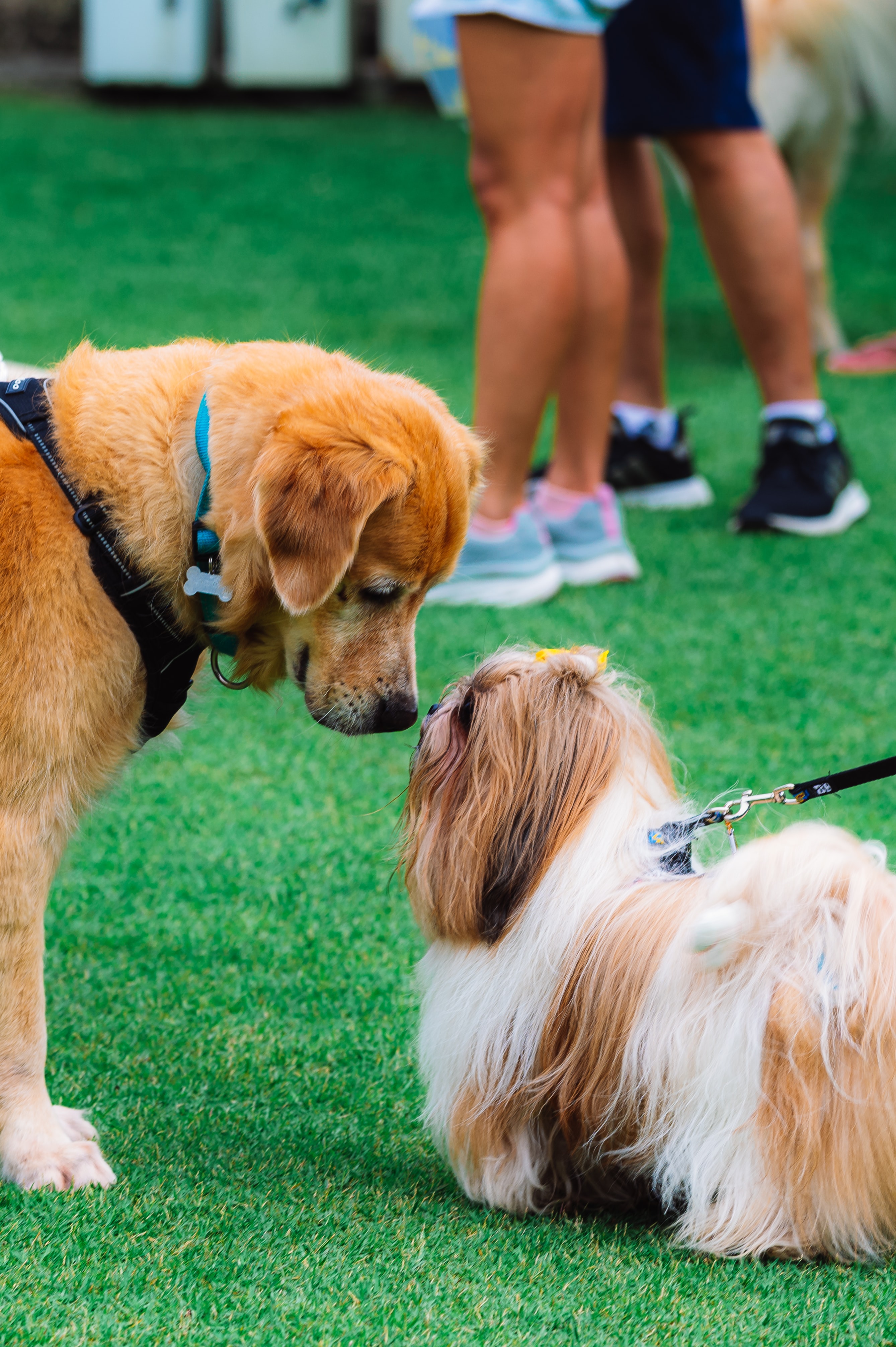Every dog owner desires a friendly, confident adult dog that adapts well to its surroundings.
Learn how to train your dog to be social so that you both can have a fulfilling life together.
Bringing a new puppy home or adding a newly adopted dog to your life comes with a huge amount of responsibility.
Keep in mind that this responsibility can be full of enjoyable challenges.
One challenge that can be enjoyable for both dog and human is learning how to train your dog to be social.
It is the new dog owners’ job to introduce new sights, sounds, objects, and people too young puppies.
Puppies need to be introduced to your world and have the opportunity to explore.
In this article, how to train your dog to be social, we will look at when to begin training, the benefits of early socialization, behaviors found in an unsocial dog, socialization checklists, and dogs encountering other dogs.
Related Articles:

How to Train Your Dog to be Social: When to Begin
The most commonly asked question is at what age should I socialize my puppy? Right now!
A puppy’s brain is still developing until the age of 5 months and changing every six months up to two years of age.
The best time to begin is between the ages of two to twelve months old.
Most experienced breeders will begin at week one.
They will introduce different sounds, textures, and a variety of toys, tunnels, and even the puppy’s first car ride those first eight weeks of their life.
- A puppy’s first year is the most crucial time for socialization.
As humans, we often have a misguided notion of what defines puppy socialization.
It’s only natural that we use the same definition for human socialization.
Puppy socialization can be simply defined as giving your puppy careful, positive exposure to anything they might encounter as an adult dog.
The end goal for learning how to train your dog to be social is ultimately your dog will know how to handle new experiences with appropriate and socially accepted behaviors.
Related Articles:
How to Train Your Dog to be Social: Benefits of Early Socialization
The results of a well-socialized puppy is seen in how they respond positively to the world around them, void of fear and aggression.
For those that adopted an older dog, you can still learn how train your dog to be social.
You will need to move slower and be consistent, but you can still see progress in most mildly fearful under socialized dogs.
Dog owners that take the time to learn how to train their dog to be social can expect to see a dog that is:
- less stressed
- less fearful
- less anxious
- learns to look at their human
- grows in confidence
Another positive result is a social puppy or dog that has the opportunity to learn canine and human body language.
They learn by being around other dogs in a training class or even participating in dog sports.
Related Articles:
- A Review Of The Top 5 Best Carpet Cleaner Solutions for Dog Urine
- A Review of the 5 Best Dog Frisbees
How to Train Your Dog to be Social: Behaviors Found in Under Socialized Dogs
Dogs that have not had early socialization often develop lifelong psychological problems.
Three characteristics seen in under socialized dogs are fearful aggression, fearful anxiety, and separation anxiety.

Four major concerns of an unsocialized dog
- A dog that is under socialized will have a difficult time at veterinarian appointments. This is a problem because the dog’s behavior could result in the veterinarian being unable to conduct a thorough examination.
- Poorly socialized dogs will see less exercise due to being fearful of car rides and anxious when seeing or meeting other dogs on walks.
- Under socialized dogs can have difficulty at the groomers. The dog may be fearful of being handled in a manner such as during bath time, grooming, and having their nails trimmed.
- A dog that is anxious can experience neurological signals that affect their hormone levels. This change or even demand on the hormones can lead to an increased heart rate, increased blood pressure and a hyper-awareness. The negative side to all those neurological and physical changes is a suppressed or stressed immune system.
It’s not uncommon for under socialized dogs to struggle as they get older.
A professional dog trainer/animal behaviorist will be able to give you tips on how to proceed with your dog.
Keep in mind each dog and case will be different.
Related Articles:
- How to Stop a Dog from Pooping in the House at Night
- How to Potty Train an Older Dog in an Apartment
- How to Train Your Dog to be Social: Socialization Checklists
As you begin to socialize your puppy develop a plan for you and your new dog. Socialization needs to be purposeful.
A key to making socialization less intense (for you and your dog) is staying positive and encouraged as you introduce your world to your dog.
One skill that is added to the list of how to train your dog to be social is handling your dog so that they are familiar with their ears, paws, nails, and body being touched.
A dog that can walk around other animals such as a cat or dogs of various sizes will do better at these medical appointments.
Plan on spending the first two years of your dog’s life exposing them to new experiences.
Two years will allow your dog to work through any built-in fear periods and growth periods.
The following checklists will give you a general idea for getting started with your dog.
This list is not an exhausted list.
Please add items to each area from your everyday life.
#1 People – How to Train your Dog to be Social
- Children (various sizes & noise levels)
- Men (tall, short, broad chests, beards, no beards)
- Women (with big coats, hats, and purses)
- Infants & their various equipment
- Toddlers crawling
- Elderly
- People in uniform
- Limping or injured people
- People wearing ball caps, winter hats, hoods, and helmets
- Running or jumping people
#2 Animals – How to Train your Dog to be Social
- Dogs of various sizes
- Different shaped dogs (long, fluffy, skinny, flat-faced)
- Dogs with different shaped ears (tall, floppy, pointed)
- Male and female dogs
- Older dogs
- Cats
- Birds
- Large animals (horses, mules, cows, llamas)
- Sheep and goats
- Chickens
- Rabbits
- Squirrels and chipmunks
#3 Handling – How to Train your Dog to be Social
- Nails & nail clipping
- Ears & ear cleaning
- Tail
- Paws touched & examined
- Teeth & cleaning
- Brushed
- Bathed
- Towel dried
- Tethered
- Bandaged
#4 Noises – How to Train your Dog to be Social
- Vacuum cleaner
- Fan
- Slamming doors
- Mopping the floor
- Kitchen appliances (high powered blender, food processor)
- Trains
- Buses
- Honking horns
- Truck brakes
- Instruments
- Doorbell
- Motorcycles
- Baby crying
- Sirens
#5 Textures – How to Train your Dog to be Social
- Sand – dry and wet
- Tile
- Carpet
- Grass – dry and wet
- Snowy surfaces
- Pavement – dry and wet
- Gravel
- Mud
- Wood floors
- Metal grates
- Foot bridges
#6 Travel – How to Train your Dog to be Social
- Hotel/Motel Room
- RV
- Campgrounds
- Tent
- Vehicle
- Rest Areas
- Walking on paved trails
- Walking/hiking on wooded trails
#7 Variety of Settings – How to Train your Dog to be Social
- Tall and short buildings
- Elevators
- Stairs
- Playground
- Crowds
- Veterinarians Office
- Groomers
- Park
- Children in strollers
- People in wheelchairs
- Barns / Stables
The above seven areas will give you ideas on where to start with learning how to train your dog to be social.
Pick and choose which areas are most relevant to your lifestyle.
- The key is to stimulate your puppy not to overwhelm them.
The most common mistake people make is taking their puppies into an environment that is too frightening. (Amusement parks and fairgrounds can overwhelm a puppy quickly.)
Know your dog’s limitations by knowing more about their breed characteristics (when possible).
Socializing your dog too quickly will only create a fearful dog.
Dogs can become fearful or anxious if they had too much exposure to ill-mannered people, children, other dogs and sudden loud noises.
In general, the more you can safely expose your dog when they are younger the less stressed they will become in new situations in years to come.
Related Articles:
How to Train Your Dog to be Social: Encountering Other Dogs
Your young dog needs to learn that seeing or being approached by a new dog can be a fine experience, not a scary one.
Structured one on one greetings are the best.
Your puppy or new dog will learn the rules of polite canine encounters (with your supervision).
It’s good to remember that each dog has their own personality.
Some dogs only care about their humans while other dogs are considered more outgoing.
Ironically this is similar to humans in that we need to be able to be polite and well-mannered around other humans.
One benefit of taking the time to socialize your puppy is having a dog that has good manners and is not anxious when encountering another dog.
Steps on how to train your dog to be social with polite dog to dog encounters.
- Teach your dog to have eye contact with you at home, in the yard, and places with distractions.
- When your dog first sees another dog, give them the cue to focus on you. Praise and/or treat your dog.
- Those first encounters with other dogs need to be quiet contactless exposures. Teach your dog to check in with you by focusing on you and not distractions. They need to know they will not be physically greeting every dog they see.
- Train your dog to sit by your side while you verbally greet someone else with a dog. Praise and treat your dog accordingly. Walk past that person.
- Once your dog is confident being in the presence of other dogs AND learning to check in with you, go to the next step.
- When allowing your dog to physically greet another dog, make sure both parties are in agreement.
- Try to be relaxed but observant. Watch the body language passed between both dogs. Dogs that greet with relaxed facial expressions, play bows, and loose wiggly back ends are friendly and comfortable.
On the flip side, know how to read a dog’s body language when they are stressed from the greeting or had enough.
Signals that your dog needs to come back to your side; they turn their head away, yawning, tense facial expressions, tails held low or straight up, hair standing up or rigid bodies.
Related Articles:
In general dog to dog greetings are best kept short while the dogs are on a leash.
Keep in mind that some dogs greet much differently when on leash versus off a leash.
The dog can feel trapped by the leash should the greeting not be friendly.
When out for a walk, pick and choose which encounters you will allow your dog to greet another dog.
Not every dog you meet wants to be greeted, they might be scared, anxious, or even aggressive.
When learning how to train your dog to be social, remember you want them to focus on you first.

Relevant Articles:
- How to Train Your Dog to Walk on a Leash
- How to Obedience Train Your Dog
- Summary: How to Train Your Dog to be Social
Early puppy socialization is key to a well-adjusted adult dog.
As with all dog training, go in with lots of patience, consistency, and praise for your pup.
When reading through the socialization checklists, try not to be overwhelmed yourself or overwhelm your dog.
Go into the training with a flexible plan for introducing your puppy to the world.
The most important goal with puppy socialization is to condition your dog to enjoy your environment and your lifestyle.
They need to be comfortable when encountering strangers, people of various sizes, tiny/large dogs, all kinds of sounds and new environments.
Relevant Articles:
- Ultimate Guide: How To Take Care Of A Puppy
- Ultimate Guide: How To Take Care Of A Dog
- Ultimate Guide: How To Take Care Of A Senior Dog
Please read our Legal Disclaimer

